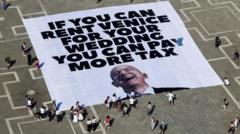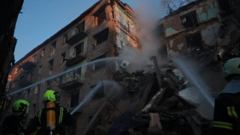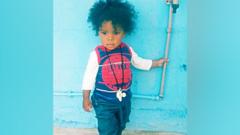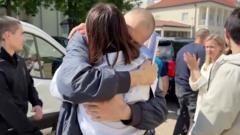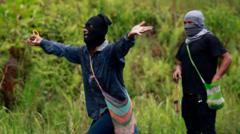In a day marked by chaos and conflict, protests erupt across Kenya, leaving at least eight dead and hundreds injured as citizens express dissatisfaction with President Ruto's administration.
Protests Turn Deadly in Kenya as Clashes with Police Result in Casualties
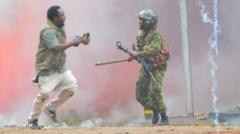
Protests Turn Deadly in Kenya as Clashes with Police Result in Casualties
Kenyan demonstrators face violent police response amid nationwide protests against government policies.
In the heart of Nairobi and other cities, thousands took to the streets chanting, “Ruto must go,” reflecting the rising anger among citizens against President William Ruto's government. On the anniversary of a turbulent period marked by protests from the previous year, this resurgence of demonstrations has resulted in at least eight fatalities and over 400 injuries, according to the Kenya Medical Association and other human rights groups.
During this unrest, police employed tear gas and water cannons to disperse crowds, which attempted to advance towards the President’s official residence but were ultimately pushed back. Ruto, who was attending a burial ceremony in Kilifi, urged the populace to maintain peace and reminded them of the consequences of unrest, stating, "We do not have another country to go to when things go wrong." His notable absence from State House sparked speculation about the severity of the protests.
The government had initially imposed a ban on live coverage of the events, a decision later overturned by Nairobi’s High Court. This did not deter demonstrators as they took to the streets waving branches symbolizing peaceful resistance. Eyewitness accounts reveal scenes of chaos, with footage depicting plumes of tear gas amid distressed crowds seeking shelter.
Among the injured, some suffered serious gunshot wounds, highlighting the brutal response of security forces. A local activist, Amina Mude, shared her motivation for participating in the protests, emphasizing a desire for better educational opportunities and a call for leadership accountability.
As tensions escalate and streets fill with mourning wreaths in remembrance of last year’s violence, the government continues to face pressure from human rights organizations like Amnesty Kenya, which reports a rising death toll. With the backdrop of a nation's urgent demands for reform, the situation in Kenya remains precarious as both sides brace for further confrontation.
During this unrest, police employed tear gas and water cannons to disperse crowds, which attempted to advance towards the President’s official residence but were ultimately pushed back. Ruto, who was attending a burial ceremony in Kilifi, urged the populace to maintain peace and reminded them of the consequences of unrest, stating, "We do not have another country to go to when things go wrong." His notable absence from State House sparked speculation about the severity of the protests.
The government had initially imposed a ban on live coverage of the events, a decision later overturned by Nairobi’s High Court. This did not deter demonstrators as they took to the streets waving branches symbolizing peaceful resistance. Eyewitness accounts reveal scenes of chaos, with footage depicting plumes of tear gas amid distressed crowds seeking shelter.
Among the injured, some suffered serious gunshot wounds, highlighting the brutal response of security forces. A local activist, Amina Mude, shared her motivation for participating in the protests, emphasizing a desire for better educational opportunities and a call for leadership accountability.
As tensions escalate and streets fill with mourning wreaths in remembrance of last year’s violence, the government continues to face pressure from human rights organizations like Amnesty Kenya, which reports a rising death toll. With the backdrop of a nation's urgent demands for reform, the situation in Kenya remains precarious as both sides brace for further confrontation.








